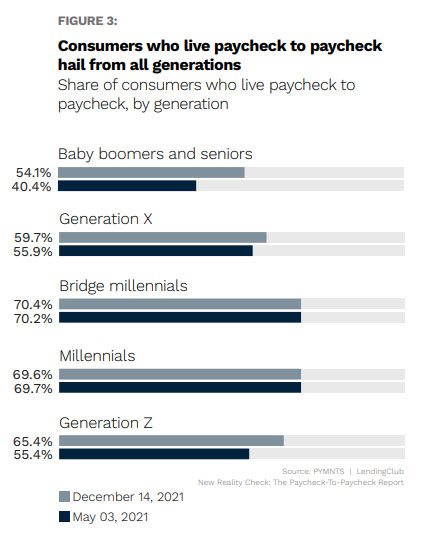We’re getting used to upheavals and disruptions at this point, but revelations of the extent of paycheck-to-paycheck living in the U.S. are impossible to ignore, and those most affected by this issue are millennials and bridge millennials who are often high earners.
For New Reality Check: The Paycheck-To-Paycheck Report – Generational Divide Edition, a PYMNTS and LendingClub collaboration, part of a series exploring this problem, we surveyed 3,070 U.S. consumers and analyzed additional economic data, finding some alarming trends.
Among those who are just getting by between checks, we found the highest number of consumers meeting that definition to be millennials and older bridge millennials.
However, they are hardly alone in making paychecks stretch to meet higher costs in 2022.
“A deep dive into the generational demographics of consumers currently living paycheck to paycheck indicates that millennials are the most likely to fall into the category, but the greatest increase in consumers living paycheck to paycheck is among baby boomers and seniors,” with 54% of baby boomers and seniors living paycheck to paycheck per Generational Divide data, the study found.
Earnings are an essential determinant as to who falls into the paycheck-to-paycheck category, although high earnings aren’t necessarily a hedge against this kind of economic pattern. For example, we found that 42% of all consumers earning above $100,000 say they’re living between checks.
Advertisement: Scroll to Continue
Savings Save the Day
Having a savings cushion is one way consumers in all demographic groups keep the wolves at bay. And there’s a silver lining of sorts here for millennials, who average higher savings than other demographic groups.
“Generation Z consumers who live paycheck to paycheck and have issues paying their monthly bills report the lowest average savings at just $1,158,” according to the report. “Millennials living paycheck to paycheck with issues paying their monthly bills report the highest savings, with an average of $3,731. Savings amounts decrease and then level off as consumers grow older.”
That “growing older” group includes Bridge millennials, along with Generation X, baby boomers and seniors who live paycheck to paycheck and struggle to pay their bills. These cohorts report having $2,765, $1,236 and $1,277 in savings, respectively.
Demonstrating the power of compound annual interest, among other financial factors, our research found that savings balances for those who don’t live paycheck to paycheck increase by generation. Boomers and seniors have the highest average savings among those living paycheck to paycheck and don’t have issues paying bills ($7,961) — and among those who don’t live paycheck to paycheck ($22,866).

The $400 Emergency Metric
A measure that’s emerged in recent years as useful in ascertaining financial health is one’s ability to have available savings or credit to cover a $400 emergency expense. That number can cover a host of scenarios from car repair to an unexpected visit to the dentist.
In New Reality Check: The Paycheck-To-Paycheck Report – Generational Divide Edition, we found that 59% of Gen Z consumers living paycheck to paycheck and struggling with bills are least likely to be unable to afford a $400 emergency expense.
That’s followed by 51% of Gen X consumers who live paycheck to paycheck and struggle to pay their bills, while 46% of bridge millennials and 44% of millennials report the same.
Get the study: New Reality Check: The Paycheck-To-Paycheck Report, Generational Divide Edition





